| Construction Rating: | starstarstarstarstar |
| Flight Rating: | starstarstarstarstar |
| Overall Rating: | starstarstarstarstar |
| Diameter: | 1.17 inches |
| Length: | 23.80 inches |
| Manufacturer: | Semroc  |
| Skill Level: | 1 |
| Style: | Scale |

Brief:
Semroc has recently started a new line of Deci-ScaleTM rocket kits that are 1/10 semi-scale models of the originals.
The IRIS is one of the first in the Deci-ScaleTM line which is a semi-scale model of the real Iris designed by Atlantic
Research Corporation in the early 1960s. This model is a 4 fin rocket with some added details that give a true scale
appearance to the finished rocket.
Construction:
I ordered my IRIS from the Semroc website and got the usual prompt and outstanding service that I have always
experienced from them. The kit comes delivered in a sealed bag with the front of the instructions displaying a color
picture and specification for the rocket. In the kit you will find:
- 1 Balsa Nose Cone
- 1 Body Tube
- 1 Engine Tube
- 1 Set of Laser Cut Fins
- 1 Ring Set (with Fin Mounts included in sheet)
- 1 Chute Pak (12” plastic)
- 1 Kevlar® Cord
- 1 Elastic Cord
- 1 Screw Eye
- 2 Launch Lugs
- 1 Engine Hook
- 1 Thrust Ring
- 2 Decals Sheets
- 2 Bands (to wrap around the body tube for detail)
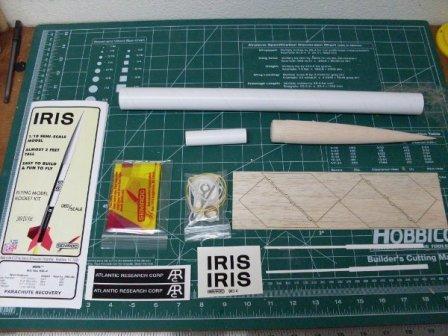 The
quality of the materials supplied was of a high grade as is normal with a Semroc kit. At a cost of $16.50, this kit is
well worth the price for what you get.
The
quality of the materials supplied was of a high grade as is normal with a Semroc kit. At a cost of $16.50, this kit is
well worth the price for what you get.
The Semroc instructions for the IRIS consist of 25 steps not including finishing. They are written as concise and easy to understand instruction with accompanying diagrams with each step. You begin with some light fin preparation sanding then start on the engine mount. The rocket uses a Kevlar® cord looped onto one end of the engine hook to act as an anchor point for the shock cord. The rest of the engine mount is glued together using the centering rings and engine thrust ring. A piece of masking tape is used around the engine tube to hold the engine hook in place. While the glue is drying, it is time to mark the body tube with the fin guide. This kit uses the standard marking method for Semroc kits by placing the body tube upright on the instruction page to mark the fin locations. I am not a fan of this method at all. After the tube is marked, you glue the engine mount into the body tube.
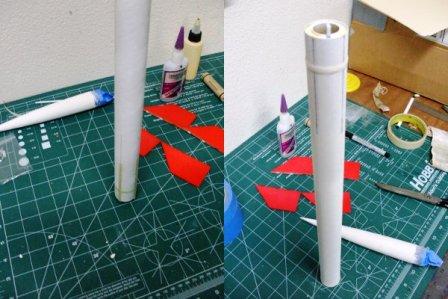
Now it is time to start working on the fins. I attached the small fin mounts in the small notches in the fins as
instructed to do so by using a small amount of white glue. Since this is a scale model, the laser cut fins have an
additional notch along the root side to accommodat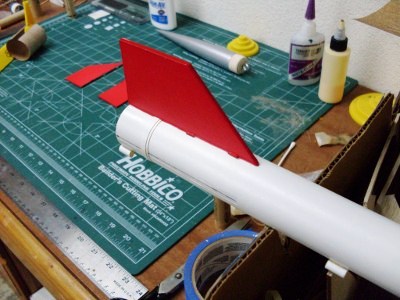 e a band that wraps around the body tube. Because of this I choose to paper the
fins so I would not get Fill ‘N Finish into the small notch or have build up near the small fin mounts. I also
decided that I would paint the fins and body tube before attaching them to the body tube. More on this will be
described in the Finishing section of this review. After I had painted my part as I wanted, I attached the bands as
described in the instructions. Then you need to attach the fins. There are no fin fillets on this rocket since it is
meant to be a semi-scale model.
e a band that wraps around the body tube. Because of this I choose to paper the
fins so I would not get Fill ‘N Finish into the small notch or have build up near the small fin mounts. I also
decided that I would paint the fins and body tube before attaching them to the body tube. More on this will be
described in the Finishing section of this review. After I had painted my part as I wanted, I attached the bands as
described in the instructions. Then you need to attach the fins. There are no fin fillets on this rocket since it is
meant to be a semi-scale model.
The final steps are to attach the launch lugs, glue the screw eye into the nose cone, attach the shock cord, and assemble the parachute. With those final steps completed, finishing is listed as the next step in the instructions. Since I had already painted the parts for my rocket separately before assembly, I should have only needed to apply the decals but things changed as you will find out.
Finishing: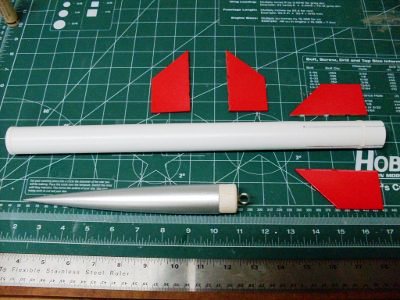
I believe the success of building a scale model resides in the care that is taken in prepping and painting the
rocket. As such, I decided to paint the rocket parts prior to assemble with the exception of the engine mount. To paint
the fins, I put some double sided tape down on a pan and situated the fins with the root side down. Since they were
papered I decided to paint them with no primer coat. My fear was that I would get paint build up on the small fin
mounts joints taking away from the appearance of the rocket. After I had painted them with several coats of red, I
realized that a couple of light coats of white p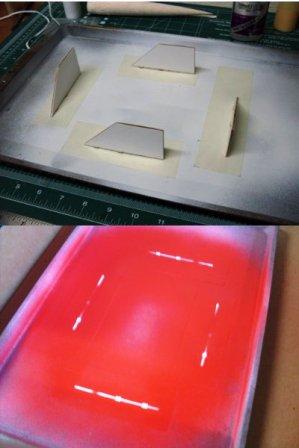 rimer would have helped. You just need to make sure that you are applying the paint
in several light coats. An issue with the fins that I didn’t count on came when I removed them from the double
sided tape. The tape was sticky enough to remove a couple of layers of paper from the fin mounts. The fins still fit
and glued nicely to the body tube.
rimer would have helped. You just need to make sure that you are applying the paint
in several light coats. An issue with the fins that I didn’t count on came when I removed them from the double
sided tape. The tape was sticky enough to remove a couple of layers of paper from the fin mounts. The fins still fit
and glued nicely to the body tube.
For the body tube I filled the spiral with watered down Fill ‘n Finish. I did the same for the nose cone after sanding it with 400 grit sandpaper. After sanding, I used 1/8” pin stripe masking tape to mask where the fins and body wraps were to be located on the rocket. I then painted the body tube with a coat of Kilz Original white spray primer. After sanding, I removed the tape to and attached the bands at the instructed positions. I re-masked the fin positions and coated the body tube with a couple of light coats of white primer. After that I used a gloss white paint to finish it off. Be certain to use light coats with some light sanding to make sure that the bands that wrap around the keep their definition. For the nose cone, I primed it with Kilz and a couple of coats of white primer. I used Rustoleum Silver Metallic spray paint for the final color.
At some point in this process I decided that would not paint the body tube with black for the roll pattern. My plan was to create some black decals and use those. My logic for doing so was based on the assumption that the Atlantic Research Corporation decal was the required width of the roll pattern and that the lettering was created with a clear decal sheet. It is actually white printed on black which is probably why there are two small decal sheets for this kit. It was also smaller than the required roll pattern width. This meant that I needed to paint the black roll pattern onto the body tube. Since I had already attached the fins to the body tube, I carefully masked around the fin mounts to achieve the scale look I was aiming for. This is much easier to do if the roll pattern is painted with the fins off the body.
Once the paint had dried for a couple of days, I positioned the decals on the rocket. I have never had any problems with Semroc decals but I put a clear coat on them before they went onto the rocket. The final step in the finishing process was to apply a coat of Future Floor Wax to the entire rocket. The finished weight of the rocket is suppose to be 1.3 ounces as listed in the instructions but mine weighted in at 1.9 ounces.
Construction Rating: 5 out of 5
Flight: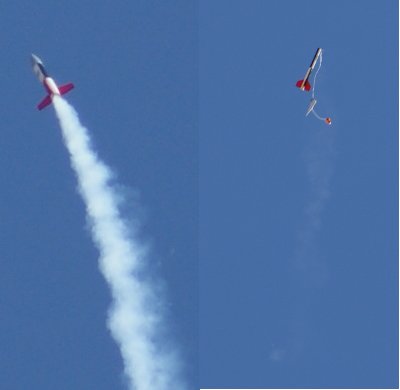
The first flight of the IRIS was on a B6-4 at a launch hosted by the Oregon Rocketry Enthusiast Organization (OREO). The rocket moved quickly off the pad to an altitude from 300’ to 400’ feet. From the roll pattern on the rocket, I could tell there was some minor spin during the flight. There was also a slight arc in the flight that was likely caused from the steady breeze on the field. The ejection happened while the rocket was still moving upward. It is a nice looking rocket as it moves upward in the sky.
Recovery:
This rocket uses a standard Semroc 12” plastic parachute. I believe that this is the proper size but cannot
confirm this since my parachute did not unfurl during decent. I was partial to blame for this since I loaded it the
night before and should have repacked the parachute before launch. The rocket landed on one of the softer spots on the
field with no damage. The shock cord that is supplied with the kit is about 24” long. I added an addition length
of cord to this to help insure that no dents would occur from snap back at ejection.
Flight Rating: 5 out of 5
Summary:
The IRIS is absolutely a beautiful semi-scale rocket from Semroc. The kit is interesting enough that keep the
advanced rocket modeler engaged in the building process and not too complicated that a modeler new to the hobby would
feel lost during the kit’s construction. With the introduction of the Deci-ScaleTM line, I believe that Semroc
will bring more people into the hobby that have an interest in semi-scale models that fly. I look forward to future
releases and have already picked up the Semroc IQSY Tomahawk for my next build.
PRO’s: Semi-scale look with parts for detailing, good price point for the quality of the kit
CON’s: Maybe the shock cord length
Overall Rating: 5 out of 5
Other:
Be sure to paint the rocket parts prior to assembly and to keep paint from the spots where you need to glue.
Other Reviews
- Semroc Iris By John "MAX" Venable (October 17, 2009)
Brief: This is another TIGHT repro from Semroc. Very Sleek and FAST.Semroc supplied me with a 24mm mount for free. Construction: The Kit consists of: 1 Balsa Nosecone, 1 Body tube, Motor tube, 4 Balsa fins, 1 screw eye, 1 thrust ring, chute pak, kevlar shock cord, launch lugs, engine hook, a set of decals. The only con about this Rocket is ...
- Semroc Iris By Chan Stevens (September 20, 2009)
Brief: The Iris is one of the first of a new sport scale line by Semroc called the Deci-Scale, each roughly 1/10th the size of the real thing. This model is based upon the Atlantic Research Corporation's sounding rocket. The kit is just for the upper stage, as the real sounding rocket flew off of different booster configurations, never on its own, so this model would not qualify ...
 |
 |
Flights
 |
 |